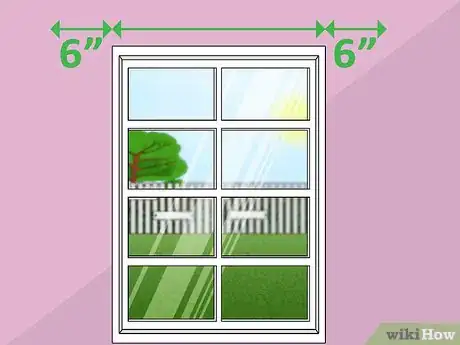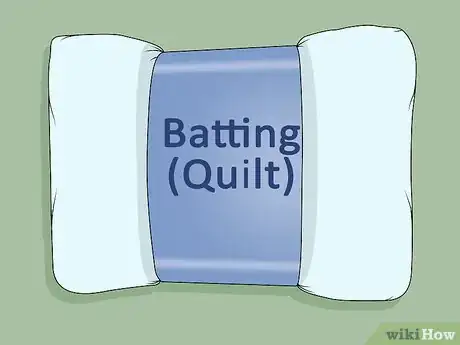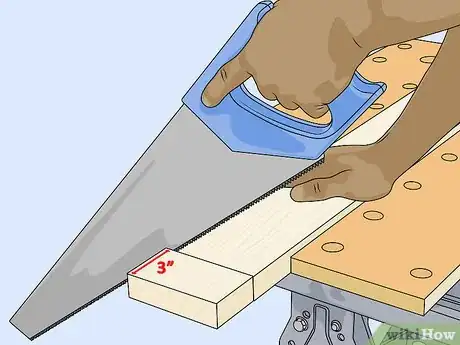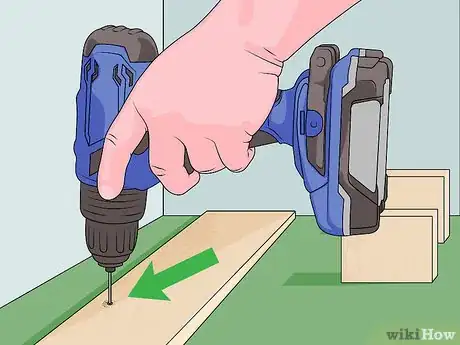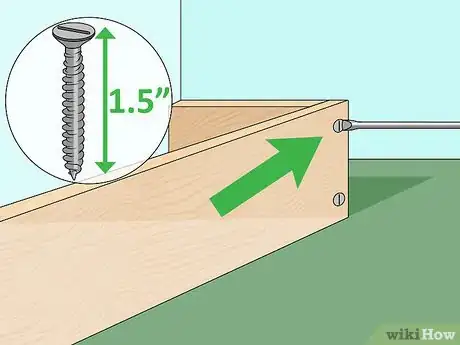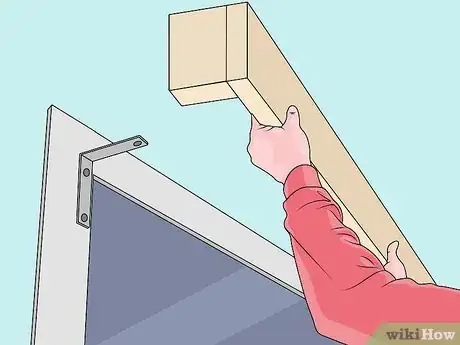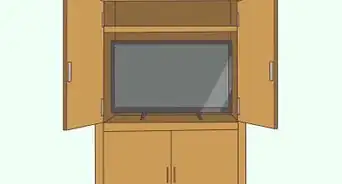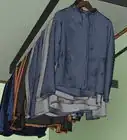This article was co-authored by Michael Fox. Michael Fox is a Window Repair Specialist and the President at Window Repair Systems and WindowHardwareDirect.com, based in Westminster, South Carolina. With over 25 years of experience, Michael specializes in commercial window repair and service. He holds a business degree from Monroe Community College and SUNY Brockport. Michael has helped Window Repair Systems and WindowHardwareDirect.com become an industry leader in commercial window repair and hardware distribution, servicing schools and businesses and training large public school systems.
This article has been viewed 23,612 times.
Want to spruce up a drab-looking window in your home? Making your own fabric-covered window cornice is a fun, easy DIY that will let you show off your creativity!
Steps
Buying Materials
-
1Measure your window. The cornice goes above the window and has to leave space for any curtains or blinds you'll have under it. Measure the window's width then add a few inches to compensate for that. Add another one or two inches for the thickness of the boards you'll use to make the cornice.[1]
- A good rule of thumb is to add six inches onto your initial width measurement.
-
2Choose your cornice boards. It's up to you what material you choose and how much you need to design the cornice, but the cornice itself can be done with three cut pieces of wood. You'll want to buy a board that is as long as the measurement of your door, but you'll also need two cuts on the ends about three inches long.
- Cornice material is often a soft wood such as pine or poplar, but it can be made from other material such as foam.
- Get wood for any decorations you choose, such as a top shelf or crown molding.
Advertisement -
3Buy mounting material. You'll need to find a way to make the cornice hang on the wall. One way to do this is to buy brackets and half-inch screws. You can also buy a thin piece of board where you'll rest the cornice before securing it from the top with more screws. All of these options can be found at local hardware stores.
- No option is preferable or sturdier to the other, so this depends on how you wish to screw into the drywall of your house.
- Bracket mounting can become complicated, as this includes finding L-shaped brackets and screwing these into both the wall and the cornice.
- Board and screw mounting is simple and good for cornices with tops, but getting the screws close enough to the walls can prove to be a tight fit.
-
4Get fabric. The fabric is what you'll wrap the cornice in before stapling it together. This forms a simple but patterned decoration. The thickness of the fabric is up to you, but the fabric will have to be cut and stapled in order to make it go on smoothly and evenly.
- Any fabric can be used, but engineered fabrics are more durable than natural fabrics. Some cottons are durable, but if you have pets and kids, it may be worth avoiding silk and rayon, for example.[2]
- Fabric isn't a mandatory choice. You can also paint the cornice or stain it.
-
5Pick up batting. Batting is cotton wadding used to insulate quilts. It has the same effect here, providing a layer of extra thickness between the cornice and the fabric. Any sort of quilt batting is appropriate for this project and is common in craft stores.[3]
- If you've chosen a thick fabric, you may not even need the batting to get the cornice to look the way you desire.
Assembling the Cornice
-
1Cut the boards. If you haven't had this done, you'll have to do it yourself. For a three-piece cornice, lay the board flat. Using a hand saw or circular saw at a 45 degree angle, cut three-inch panels off both ends. These will be the boards that connect the cornice to the wall.[4]
-
2Drill holes into the wood. Where you drill the holes depends on how you want to assemble the cornice pieces. These holes can be drilled directly into the small pieces near where they will attach to the larger board or they can be drilled on the larger board over where the small pieces will attach.[5]
-
3Attach the wood panels together. Using 1.5 inch wood screws, fasten the three pieces of the cornice together. Wood glue is useful for extra security. At this point you should have a flat board attached to two legs.
-
4Paint or stain the wood. The options for decorating a plain cornice are limited only by the imagination. Choose a coat of paint that goes with your room or buy a wood stainer. You can apply sealer and let it sit for a few hours before applying stainer, but this isn't necessary to make the color even.
- With a brush or cloth, paint the cornice evenly on all sides.
-
5Mount the cornice. Once the cornice looks complete, bring it up to the wall. If you are using brackets, slide it over the brackets and screw them together. Another option is to use a thin base of wood secured to the wall. For this option, put screws on the roof of the cornice as close to the wall as possible. Screw them down through the cornice and into the wall mount.
Adding Fabric
-
1Cut your fabric and batting. Lay out the fabric and, with a pair of scissors, reduce it to the appropriate size. Both the fabric and batting will wrap around the cornice, so you'll want to make it proportionately bigger, for example six inches wider and 12 inches longer than the cornice board.
- Remember that you'll have an opportunity to trim the fabric later.
-
2Iron out the fabric. Keep it laid out on a flat surface. Pass an iron over it to remove any wrinkles. This ensures the fabric looks its best when you hang it.
-
3Wrap the cornice in batting. Lay the remaining batting out flat. Put the cornice in the center of it. Pull one side over to the center, then do the same with the other side. The material should fit snugly. With a staple gun start in the center and move outward, stapling the material on opposite sides at intervals.
- Other adhesives, such as glue and tape, can be used.
-
4Cut excess batting. At the corners where the cornice will meet the wall, fold the batting downwards onto the wood. Cut what you don't need. Fold the remaining batting so that it appears neat. It should not be sticking up anywhere at this point.
-
5Wrap the cornice in fabric. Place the fabric print-side down, flat, and center the cornice on it. Do what you did to the batting again with the fabric. Pull one side over the center, the pull the other side over to meet it. Keep the fabric firm so that no area bunches and becomes uneven.
-
6Secure the fabric. Trim off the excess at the corners. The fabric should securely wrap all the way around the cornice and lay flat. Take the staple gun and, starting at the center, staple it to connect the ends and the batting.
-
7Mount the cornice. Secure the cornice to the brackets with screws, if you used them. Another option is to use a thin base of wood secured to the wall. For this option, put screws on the roof of the cornice as close to the wall as possible. Screw them down through the cornice and into the wall mount.[6]
Things You'll Need
- Wood or substitute boards
- Wood and drywall screws
- Measuring tape
- Saw
- Staples
- Fabric
References
- ↑ https://snapguide.com/guides/make-a-fabric-covered-window-cornice/
- ↑ http://www.forbes.com/sites/houzz/2013/12/11/bulletproof-decorating-upholstery-that-stands-up-to-anything/#22d6a9ea52c2
- ↑ http://mattandshari.com/sewing/window-coverings/the-classic-a-fabric-covered-cornice-board/
- ↑ https://www.thisoldhouse.com/how-to/how-to-build-window-cornice
- ↑ http://www.shanty-2-chic.com/2015/02/diy-wooden-window-cornice.html
- ↑ http://www.remodelaholic.com/build-hang-window-cornice/
